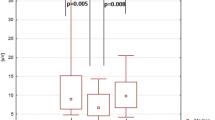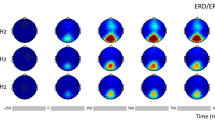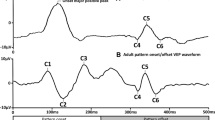Abstract
The left-right asymmetry in the potential amplitude on the scalp was studied in poststroke patients by using flash visual evoked potential (VEP) and a numerical two-dimensional model of the head. The left-right asymmetry of the VEP was measured in three patients after thrombosis, in one after hemorrhage, and in one healthy subject. The numerical model used computed tomography images to define the different comparttential distribution created by a dipole source in the occipital region was solved numerically with use of a finite volume method. Left-right asymmetry was calculated with serveral values of conductivity of the damaged region. The experimental results revealed a negative asymmetry in the three patients after thrombosis (i. e., the potential amplitude over the ischemic hemisphere was smaller than that over the intact hemisphere), whereas, in the patient after hemorrhage, a positive asymmetry was found. Nonsignificant left-right asymmetry was found in the healthy subject. The numerical model revealed that the electrical conductivity of the damaged tissue has a major effect on the left-right asymmetry. Negative asymmetry, such as that found for patients after thrombosis, was obtained when the conductivity of the damaged region was greater than that of the brain, whereas positive asymmetry (hemorrhage patient) was obtained when that conductivity was smaller than that of the brain. This finding indicates that the left-right asymmetry in the scalp VEP of patients after brain damage may be a result of changes in the conductivity of the volume conductor (the ischemic region) between the source and the electrodes.
Similar content being viewed by others
References
Abboud, S., Y. Eshel, S. Levi, and M. Rosenfeld, Numerical calculations of the potential distribution due to dipole sources in a spherical model of the head.Comp. Biomed. Res. 27:441–455, 1994.
Cuffin, B. N. Effects of fissures in the brain on electroen-cephalograms and magnetoencephalograms.J. Appl. Phys. 57:146–153, 1985.
Cuffin, B. N. Effects of head shape on EEG's and MEG'sIEEE Trans. Biomed. Eng. 37:44–52, 1990.
Cuffin, B. N. Effects of local variations in skull and scalp thickness on EEG's and MEG's.IEEE Trans. Biomed. Eng. 40:42–48, 1993.
Duda, R. O., and P. E. Hart.Pattern Classification and Scene Analysis. New York: John Wiley and Sons, 1973.
Eshel, Y., S. Levi, M. Rosenfeld, and S. Abboud. Correlation between skull thickness asymmetry and sealp potential estimated by a numerical model of the head.IEEE Trans. Biomed. Eng. 42(3):242–249, 1995.
Geddes, L. A., and L. E. Baker. The specific resistance of biological material: a compendium of data for the biomedical engineer and physiologist.Med. Biol. Eng. 5:271–293, 1967.
Harmony, T., J. Richard, G. Otero, G. Fernandez, S. Lorente, and P. Valdes. Symmetry in the visual evoked potential in normal subjects.Electroenceph. Clin. Neurophysiol. 35:237–240, 1973.
He, B., T. Musha, Y. Okamoto, S. Homma, Y. Nakajima, and T. Sato. Electric dipole tracing in the brain by means of the boundary element method and its accuracy.IEEE Trans. Biomed. Eng. 34:406–414, 1987.
Hoeppner, T. J., D. Bergen, and F. Morrell, Hemispheric asymmetry of visual evoked potentials in patients with well-defined occipital lesions.Electroenceph. Clin. Neurophysiol. 57:310–319, 1984.
Jain, A. K.Fundamentals of Digital Image Processing. Englewood Cliffs, NJ: Prentice-Hall, 1989.
Jonkman, E. J., A. C. Van Huffelen, and G. Pfurtscheller. Quantitative EEG in cerebral ischemia. In:Clinical Application of Computer Analysis of EEG and Other Neurophysiological, edited by F. H. Lopes da Silva, Amsterdam: Elsvier, 1990, pp. 205–237.
Kappelle, L. J., A. C. van Huffelen, and J. van Gijn. Is the EEG really normal in lacunar stroke?J. Neurosurg. Psychiatry 53:63–66, 1990.
Klassen, A. C., L. M. Heaney, M. C. Lee, and F. Torres. Hypercapnic alteration of visual evoked responses in acute cerebral infarction.Arch. Neurol. 36:627–629, 1979.
Kopruner, V., and G. Pfurtscheller. Multiparametric asymmetry score: distinction between normal and ischemic brains.Electroenceph. Clin. Neurophysiol. 57:343–346. 1984.
Kopruner, V., G. Pfurtscheller, and L. M. Auer; In:Brain ischemia: Quantitative EEG and Imaging Techniques, Progress in Brain Research, vol. 62, edited by G. Pfurtscheller, E. J. Jonkman, and F.H. Lopes da Silva, Amsterdam: Elsevier Science Publishers B. V., 1984, pp. 29–50.
Nunez, P. L.,Electric Fields of the Brain, New York: Oxford University Press, 1981.
Oosterhuis, H. J., L. Ponsen, E. J. Jonkman, and O. Magnus. The average visual response in patients with cerebrovascular disease.Electroenceph. Clin. Neurophysiol. 27:23–34, 1969.
Rosenfeld, M., D. Kwak, and M. Vinokur. A fractional step solution method for the unsteady incompressible Navier-Stokes equations in generalized coordinate systems.J. Comp. Phys. 94: 102–137, 1991.
Wesseling, P. Cell-centered multigrid for interface problems. In:Multigrid Methods, Theory, Applications, and Supercomputing. edited by S. F. McCormict. New York, Marcel Dekker Inc., 1988, pp. 631–641.
Yan, Y., P. L. Nunez, and R. T. Hart. Finite-element model of the head: scalp potentials due to dipole sources.Med. & Biol. Eng. & Comp. 29:475–481, 1991.
Author information
Authors and Affiliations
Rights and permissions
About this article
Cite this article
Abboud, S., Bar, L., Rosenfeld, M. et al. Left-right asymmetry of visual evoked potentials in brain-damaged patients: A mathematical model and experimental results. Ann Biomed Eng 24 (Suppl 1), 75–86 (1995). https://doi.org/10.1007/BF02770997
Received:
Revised:
Accepted:
Issue Date:
DOI: https://doi.org/10.1007/BF02770997




